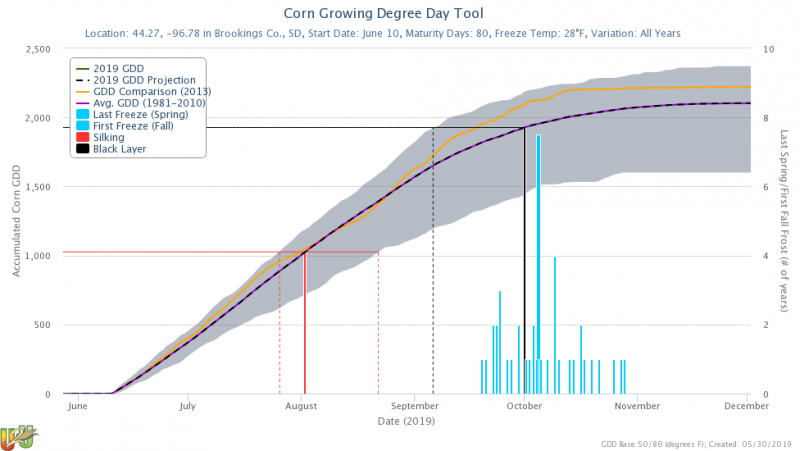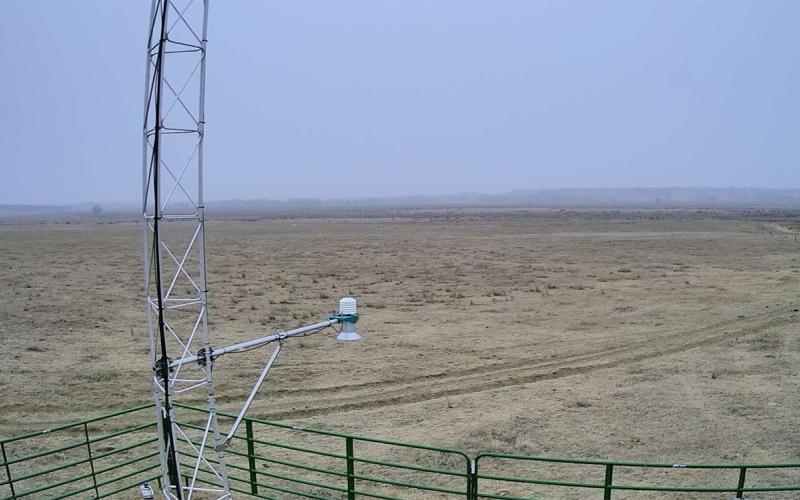Originally Published: May 30, 2019
Written with contributions by Jonathan Kleinjan, former SDSU Extension Agronomist.
Growth and development in crops are a direct response to accumulated heat units or growing degree days (GDD) starting the day they are planted. The Corn GDD Tool at the High Plains Regional Climate Center can be a useful resource for not only estimating crop growth stage but also for selecting hybrids within the appropriate maturity group. This online tool updates daily with temperature observations across the Corn Belt region.
The Corn GDD Tool can compare current season’s accumulated GDD to the 30-year average (1981-2010) and also with any individual year since 1981. For many Eastern S.D. locations, current season’s GDD are among the lowest since 1981.
Corn GDD Scenarios
Using the Corn GDD Tool, a few scenarios were considered for South Dakota. First, if corn was planted in mid-April, accumulated GDDs are only about 100 behind the 30-year average for this time of year. This is not a substantial gap to make up later in the season.
Second, other similar years that had slower starts were 2013 and 1997. Both of those seasons were cooler than average through much of the summer, and then warmed up at the end of the season and gained GDD quickly in September. The current NOAA climate outlook for S.D. has leaned towards wet and cool through July and then favors a warmer late summer-early fall. It is possible, but not guaranteed, that we could still successfully compensate for early season’s lost GDD later in the summer if this long-term outlook holds true.
Third, the Corn GDD Tool can be utilized to help determine what maturity might work best for your county. This would be a benefit if there is a consideration to change to a shorter maturity hybrid. Some examples that were simulated in the tool for June 10 planting dates indicate that 95 day/2300 GDD maturity hybrid might work better for southern and southeastern areas such as Mitchell and Elk Point so that the crop may reach black layer stage around the same time as average fall frost dates around October 5-10. In the northern areas such as Aberdeen or Redfield, an 85 day/2100 GDD maturity hybrid would reach black layer around the time of average fall freeze. Granted, reaching black layer at fall frost is not necessarily ready for harvest. If you do not have grain drying capability, this may be a concern.
Example
An example from Brookings county is shown below. Corn is planted on June 10, an 80 day/1950 GDD maturity hybrid would likely reach black layer just before the average fall frost date if accumulated GDDs are near average for the rest of the season. Average GDD accumulation is the dotted black line, starting from June 10. The graph shows the vertical black line (black layer date) just a few days ahead of the vertical thick blue line (average fall frost date). In this scenario, silking would occur in early August (red vertical line). The orange line shows how 2013 accumulated GDD progressed through the season, if corn had been planted on June 10.

In Summary
As the growing season progresses, the Corn GDD Tool will track accumulations daily. This may serve as a useful tool as marketing decisions are made, or to plan for end of season harvest and drying.


